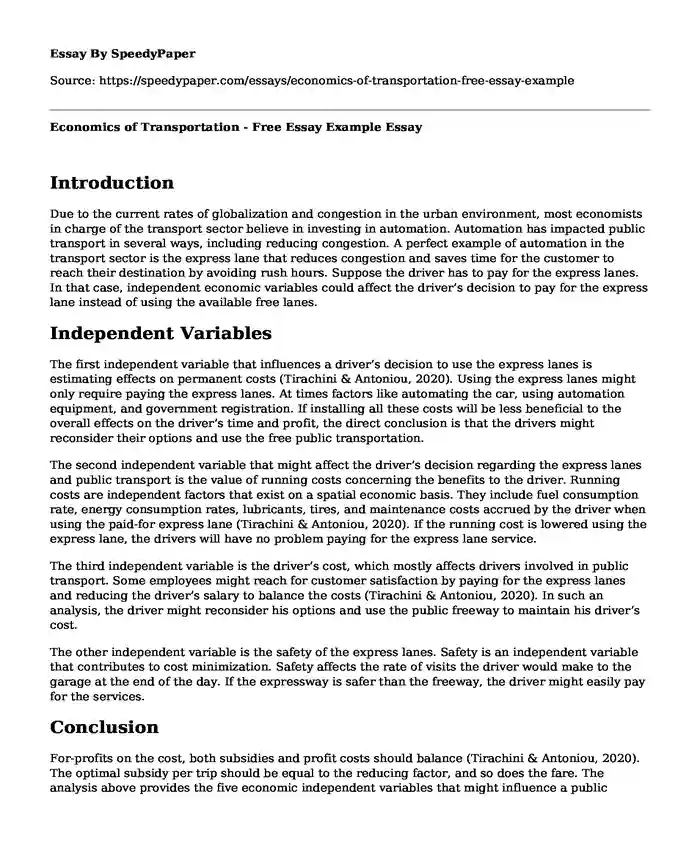
| Type of paper: | Essay |
| Categories: | Globalization Economics Automotive industry |
| Pages: | 2 |
| Wordcount: | 494 words |
Introduction
Due to the current rates of globalization and congestion in the urban environment, most economists in charge of the transport sector believe in investing in automation. Automation has impacted public transport in several ways, including reducing congestion. A perfect example of automation in the transport sector is the express lane that reduces congestion and saves time for the customer to reach their destination by avoiding rush hours. Suppose the driver has to pay for the express lanes. In that case, independent economic variables could affect the driver’s decision to pay for the express lane instead of using the available free lanes.
Independent Variables
The first independent variable that influences a driver’s decision to use the express lanes is estimating effects on permanent costs (Tirachini & Antoniou, 2020). Using the express lanes might only require paying the express lanes. At times factors like automating the car, using automation equipment, and government registration. If installing all these costs will be less beneficial to the overall effects on the driver’s time and profit, the direct conclusion is that the drivers might reconsider their options and use the free public transportation.
The second independent variable that might affect the driver’s decision regarding the express lanes and public transport is the value of running costs concerning the benefits to the driver. Running costs are independent factors that exist on a spatial economic basis. They include fuel consumption rate, energy consumption rates, lubricants, tires, and maintenance costs accrued by the driver when using the paid-for express lane (Tirachini & Antoniou, 2020). If the running cost is lowered using the express lane, the drivers will have no problem paying for the express lane service.
The third independent variable is the driver’s cost, which mostly affects drivers involved in public transport. Some employees might reach for customer satisfaction by paying for the express lanes and reducing the driver’s salary to balance the costs (Tirachini & Antoniou, 2020). In such an analysis, the driver might reconsider his options and use the public freeway to maintain his driver’s cost.
The other independent variable is the safety of the express lanes. Safety is an independent variable that contributes to cost minimization. Safety affects the rate of visits the driver would make to the garage at the end of the day. If the expressway is safer than the freeway, the driver might easily pay for the services.
Conclusion
For-profits on the cost, both subsidies and profit costs should balance (Tirachini & Antoniou, 2020). The optimal subsidy per trip should be equal to the reducing factor, and so does the fare. The analysis above provides the five economic independent variables that might influence a public driver’s decision to pay for the express lanes at the expense of using the freeways.
References
Tirachini, A., & Antoniou, C. (2020). The economics of automated public transport: Effects on operator cost, travel time, fare and subsidy. Economics of Transportation, 21, 100151.
Cite this page
Economics of Transportation - Free Essay Example. (2023, Dec 25). Retrieved from https://speedypaper.com/essays/economics-of-transportation-free-essay-example
Request Removal
If you are the original author of this essay and no longer wish to have it published on the SpeedyPaper website, please click below to request its removal:
- Race and Class in Latin America, Free Essay
- Paper Example on How to Implement Change Using Kotter's Eight-Step Plan
- Essay Sample on The Decision of LG Corporation
- Products and Branding. Free Essay
- Hotel Brand Communication: Leveraging Social Media to Reach Clients - Research Paper
- Essay Sample on Ethics in the Digital Age
- Free Paper on Creating a Marketing Research Plan a Mobile Grocery Store
Popular categories




